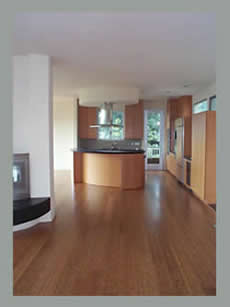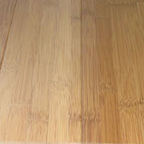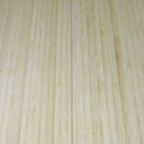|
|
|
|
|
|
|
|
|
|
GREENFLOORS BAMBOO CLICK
FLOORS |
|
|
|
|
|
GreenFLoors
Bamboo Click Flooring offers the most versatile bamboo flooring system.
Its can be floated over almost any type of dry, flat, structurally sound
subfloor. Our click series are a completely glueless/click-on system.
are a completely glueless/click-on system.
Bamboo is a grass,
not wood. Bamboo produces new shoots each year and is individually
harvested from controlled forests within 4 to 5 years. Since it is a
fast growing and replenishable, it won't hurt our rainforests.
Furthermore, we only use Mao Zhu (hairy bamboo) for our GreenFloors Bamboo
Click Floors, one of the hundreds of bamboo species not consumed by
pandas.
Nothing can compare
with the beauty of nature. The distinct grains provide the elegant pattern
which is not only unique but
can compliment any decor in your room. GreenFloors offers two colors,
natural and carbonized (darker brown), in matte finish. We also offer
unfinished planks which can be stained in any color of your choice. |
|
|
|
|
|
|
|
|
|
|
|
|
|
|
|
|
|
|
|
|
|
|
|
|
|
|
| |
|
|
|
|
| |
Carbonized |
|
Natural |
|
| |
 |
|
 |
|
|
For Availability And Pricing Please
Call Us At: (703)352-8300 |
| |
|
Attributes
That Make Bamboo Floors “Green” |
|
Renewable |
Rapidly Renewable
One of bamboo's greatest
benefits is the rate at which it renews itself. The three-to-five year
harvest cycle makes bamboo a rapidly renewable material, which is generally
defined as having a harvest rotation of 10 years or less. In contrast, most
hardwood species used for flooring reach saleable size in 50 to 100 years.
Bamboo is a member of the
grass family that "matures in three years, regenerates without need for
replanting and requires minimal fertilization or pesticides."1 |
|
Recycled Content |
Recycled Content Product
To be considered a recycled
content material, the product should contain a certain amount of either post
consumer or post-industrial waste material. This is generally presented as a
percentage of the total weight. The LEED
Rating System has used 20 percent post consumer and 40 percent
post-industrial as minimum requirements for a product to be considered
recycled content.
Some bamboo flooring
products may be laminated over a core material made from medium density
fiberboard (MDF), which generally contains some post-industrial wood fiber.
The OSB flooring product also contains post-industrial recycled bamboo. It
may-depending on the content percentage-be potentially considered a
recycled-content material. |
|
Recycability |
Some manufacturers also
offer an engineered floor that utilizes a thin bamboo layer laminated over a
non-bamboo material. One manufacturer now offers tongue-and-groove flooring
made from bamboo-oriented strand board (OSB). This product is made using the
post-industrial waste bamboo from floor manufacturing. |
|
Toxicity
|
Bamboo growing requires
minimal fertilization or pesticides. According to the U.S. EPA, Americans
spend nearly 90 percent of their time indoors. Therefore, evaluating how
products impact IEQ is necessary. These impacts may include emissions of
volatile organic compounds (VOC) and/or formaldehyde. Several factors should
be considered when looking at the indoor environmental quality impacts of a
material. For example, these may include ventilation rates of the space
applied, decay rates for volatile components, and the overall emissions from
other components.
Volatile Organic Compounds
- At this time, little data is available relative to the emissions of VOC
from bamboo flooring material.
Formaldehyde - Some bamboo
flooring products are manufactured using formaldehyde-based adhesives, and
formaldehyde emissions vary from brand to brand. Some brands claim the use
of formaldehyde-free glues and finishes. Some manufacturers reported
formaldehyde emissions at various ranges, from 16 ug/m3 to 330 ug/m3.
The California Office
of Environmental Health Hazard Assessment has listed formaldehyde as
a "chemical of special concern." The agency has published the reference
exposure levels (RE L) for toxicity for both
Chronic7
(3 ug/m3) and
Acute
(94 ug/m3 for 1 hour) exposures.
If you are considering
bamboo flooring, inquire about VOC and formaldehyde emissions from the
specific manufacturer or distributor. VOC and formaldehyde emissions should
also be considered when choosing adhesives for glue-down installations, in
the surface finishing material, and in the choice of sub floor materials. |
|
Life Cycle
|
Durable materials require
less frequent replacement, generate less waste, and may also realize lower
long-term costs. According to manufacturers, bamboo flooring should last a
lifetime (30 to 50 years). The onetime costs of installing bamboo flooring
should be less than the costs for multiple installations of less durable
flooring options. Therefore, over the long-term, the consumer should save
money. Replacing the flooring generates waste, so reducing the rate of
replacement also reduces waste generation. Without a single standard
measurement for durability, the only comparable data available at this time
are the results from standard Janka-Ball Hardness tests (ASTM D1037). Bamboo
flooring ranges "from slightly lower than red oak (1290 PSI) to
significantly harder- 1130 PSI to 1640 PSl,"5
making it a relatively hard material.
Since most bamboo flooring
can be refinished, it should have a longer life than less durable flooring
options such as carpet and some resilient flooring. The following list is
from the Residential Rehabilitation Inspection Guide of the U.S.
Department of Housing and Urban Development.6
Based on information provided by manufacturers and trade associations;
it shows the life expectancy of several common flooring components used in
residential applications: Oak or pine: lifetime. Slate flagstone: lifetime.
Vinyl (sheet or tile) 20-30 years. Terrazzo: lifetime. Carpeting: 11 years.
Marble: lifetime.
Since bamboo has a relative
hardness comparable to oak, a very hard, durable wood, and exhibits similar
properties to other wood floors, it is assumed to have a life expectancy
comparable to wood flooring. |
|
Installation
|
Bamboo flooring can be used
in most residential and commercial applications where carpet, wood, tile, or
resilient flooring is used. Some applications may be inappropriate a-high
moisture area, for example-so consumers should confirm with the supplier to
make sure the application is appropriate.
Depending upon the product,
installation may be glue-down or nail down. In engineered products, bamboo
may be floated, and it can be used with concrete or wood sub floors. |
|
Maintenance
|
Manufacturers report that
bamboo floors are maintained in the same manner as wood floors and can be
refinished. |
|
Social Responsibility |
Life-cycle analysis often includes examining
environmental justice issues. Since most bamboo for flooring originates in
the Asian Pacific Rim, the question of fair labor practices is a legitimate
concern in the production and manufacture. To date, these practices have not
been well documented. As a result, local product distributors may not have
much direct control or be willing to say much about this issue. |
|
Manufacturer Processes |
Bamboo is harvested, sliced
into strips, boiled in water with a preservative, and pressed flat. It is
then laminated vertically or in three horizontal layers, and kiln-dried.
Floors manufactured using the horizontal orientation may be prone to
cupping, but this problem is eliminated when the center layer is oriented
perpendicular to the top and bottom layers.
Some manufacturers also
offer an engineered floor that utilizes a thin bamboo layer laminated over a
non-bamboo material. One manufacturer now offers tongue-and-groove flooring
made from bamboo-oriented strand board (OSB). This product is made using the
post-industrial waste bamboo from floor manufacturing.
Bamboo flooring products
are manufactured in varying dimensional tongue and groove strip sizes and
lengths. These products are available either pre-finished or unfinished, and
they are usually offered as either natural or amber colored. Costs range
from $4 to $8 per square foot for higher quality products. |
|
Distribution Methods |
Transportation Issues
Nearly all bamboo for
flooring is grown and manufactured in the Pacific Rim, generally in China or
Vietnam. Therefore, any life-cycle analysis of these products should take
into account both energy consumption and air emissions resulting from the
transportation requirements of bringing the bamboo to market.
Some green building rating
systems or guidelines give preference to the use of materials that either
originate or are manufactured locally, which is often defined as within a
500-mile radius from the project. |
|